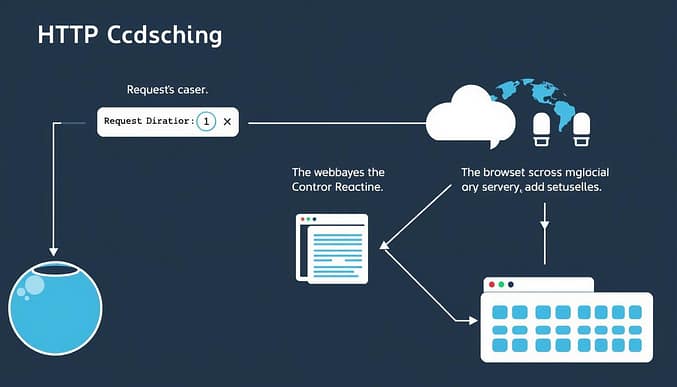Cache Control Header Explained: What It Is and Why It Matters
Modern websites rely on efficient data delivery to keep users engaged. The Cache-Control header plays a critical role in this process by managing how browsers and CDNs store web resources. This HTTP specification acts as a rulebook for temporary storage, balancing speed and freshness for content like images or scripts.
When a server sends a response, it includes directives like max-age=604800, telling clients how long to retain files locally. These instructions prevent unnecessary reloads of unchanged assets while ensuring updates reach users promptly. For instance, setting public allows shared caches to store responses, whereas private restricts storage to individual browsers.
Proper configuration reduces strain on origin servers and minimizes network traffic. A well-tuned setup can slash load times by 30% or more, directly impacting bounce rates and conversions. The header’s flexibility makes it essential for developers optimizing caching behavior across diverse platforms and user scenarios.
Key Takeaways
- Governs how browsers and CDNs store website resources
- Uses directives like max-age to set storage duration limits
- Supports both public (shared) and private (browser-only) caching
- Reduces server load through efficient content reuse
- Critical for balancing performance with content freshness
- Directly impacts page speed metrics and user retention
Introduction to HTTP Caching and Cache-Control Headers
Behind every quick-loading webpage lies a crucial system of temporary storage. HTTP caching allows browsers to keep copies of fonts, images, and scripts locally, cutting load times by eliminating repeat downloads. When visitors return to a site, their browser cache checks stored files first—only fetching new data when necessary.

How Resource Storage Works
Servers send cached files with expiration rules through headers. A fresh response means the stored copy is still valid, while a stale one triggers a network request for updates. For example:
Cache-Control: max-age=3600keeps files for one hourpublicdirectives allow CDNs to store content
Speed Meets Efficiency
Properly configured caching slashes bandwidth use by up to 60% according to cache-control best practices. Users get instant page renders, while servers handle fewer requests. This dual benefit makes HTTP caching indispensable for modern web performance—turning occasional visitors into engaged users.
“Caching is the silent workhorse that makes the web feel instantaneous.”
Understanding What is Cache Control Header
Optimizing how browsers store data transforms site efficiency. The Cache-Control header specifies rules for temporary storage of CSS files, images, and scripts. Unlike older methods like the Expires header, it uses relative time values (max-age=604800) that remain accurate across time zones.

Definition and Basic Concepts
Freshness determines how long a stored resource remains valid. When max-age=3600 expires, the file becomes stale. Browsers then send conditional requests to check for updates—a process called revalidation.
Intermediate caches follow public or private rules. Shared proxies cache public assets, while private ones handle user-specific data like account pages. This prevents sensitive information from being stored improperly.
Role in Optimizing Website Performance
Proper directives slash origin server workloads. A CDN serving cached JavaScript files reduces response times from 800ms to 80ms. Studies show sites using s-maxage for shared caches cut bandwidth costs by 40%.
Faster resources load keep bounce rates low. Visitors stay engaged when pages render instantly—a direct result of precise caching rules. As one engineer noted: “Cache-Control turns sluggish sites into smooth experiences.”
Exploring Cache-Control Directives and Their Usage
Effective web performance hinges on precise caching strategies. The Cache-Control header offers granular control through specific instructions that shape how servers and clients handle stored resources. Developers use these rules to optimize delivery speeds while maintaining content accuracy.
Common Directives: max-age, no-cache, and no-store
Three core instructions govern most caching scenarios:
- max-age=3600: Stores files for 1 hour (e.g., CSS stylesheets)
- no-cache: Requires revalidation before reuse (ideal for payment portals)
- no-store: Blocks storage entirely (sensitive user data)
A Cache-Control: max-age=86400 header tells browsers to retain logo images for 24 hours. In contrast, no-store ensures medical records never linger in temporary storage.
Additional Directives: s-maxage, immutable, and stale-while-revalidate
Advanced use cases benefit from specialized instructions:
| Directive | Purpose | Example |
|---|---|---|
| s-maxage | Overrides max-age for CDNs | s-maxage=604800 |
| immutable | Prevents revalidation for static files | immutable |
| stale-while-revalidate | Serves stale content during updates | stale-while-revalidate=300 |
News sites often use stale-while-revalidate=60 to display articles while checking for breaking updates. Static assets like versioned JavaScript files pair well with immutable, eliminating unnecessary requests.
Choosing the right mix requires understanding user needs. As highlighted in best practices for cache headers, directives like s-maxage reduce origin server strain by 50% in high-traffic applications. Balancing freshness and efficiency remains key—long cache times boost speed, while shorter periods ensure accurate content.
Browser Cache vs. CDN and Shared Caches
Web performance depends on layered storage systems working in harmony. Each layer—browser cache, CDN, and shared caches—serves distinct roles in accelerating content delivery while managing network traffic.
Browser Cache Fundamentals and Local Storage
A local cache stores website assets directly in users’ browsers. This eliminates repeated downloads for common elements like logos or stylesheets. Key benefits include:
- Instant page reloads for returning visitors
- 60% reduction in data usage for frequent users
- Offline access to recently viewed pages
Chrome and Firefox automatically manage this storage, typically retaining files for hours or days based on Cache-Control rules.
CDN Caching and Shared Cache Strategies
Content Delivery Networks store copies across global servers. Unlike browser-specific storage, CDNs serve multiple users through shared caches. This approach:
- Reduces latency by serving files from nearby locations
- Handles traffic spikes without overwhelming origin servers
- Requires precise s-maxage directives for expiration control
| Storage Type | Configuration Example | Best For |
|---|---|---|
| Browser Cache | Cache-Control: max-age=86400 |
User-specific assets |
| CDN Cache | Cache-Control: public, s-maxage=604800 |
Global static content |
News sites often combine both strategies—using local storage for article text and CDNs for high-resolution images. This dual approach cuts web page load time by 40% compared to single-layer caching.
Configuring Cache-Control for Better Web Performance
Fine-tuning server settings unlocks maximum speed while maintaining content accuracy. Strategic header configurations balance fast load times with up-to-date resources—a critical factor for user retention and SEO rankings.
Static vs. Dynamic Content Strategies
Servers handle static and dynamic assets differently:
| Content Type | Directive Example | Effect |
|---|---|---|
| Static (logos) | Cache-Control: public, max-age=31536000 |
1-year browser storage |
| Dynamic (prices) | Cache-Control: no-cache, must-revalidate |
Requires hourly checks |
Combine directives carefully. For login pages:
- private prevents shared storage
- max-age=1800 limits session data retention
- no-store blocks sensitive info caching
E-commerce sites using stale-while-revalidate=300 saw 22% faster product page loads. This approach serves slightly outdated inventory counts while updating them in the background.
Avoid these common mistakes:
- Setting 1-year cache times on changing assets
- Using
publicfor user-specific responses - Ignoring
Varyheaders for localized content
Proper configuration reduced one media site’s server load by 58%—translating to $12,000/month in saved bandwidth costs. As one DevOps engineer noted: “Smart caching turns infrastructure constraints into competitive advantages.”
Cache Busting and Versioning: Keeping Content Fresh
Stale files can sabotage user experiences even with perfect caching rules. Cache busting forces browsers to fetch updated assets when developers deploy changes, ensuring visitors always see the latest version of your site.
Implementing Asset Hashing and URL Versioning
Unique identifiers break cached content effectively. When a JavaScript file gets updated, its filename changes:
- Original: app.js
- Hashed: app.a1b2c3.js
- Versioned: react.2.1.8.min.js
Browsers treat these as new resources, triggering fresh downloads. This method pairs perfectly with long max-age settings and immutable directives—files remain cached indefinitely until their identifiers change.
Techniques for Effective Cache Busting
Choose strategies based on your tech stack:
| Method | How It Works | Example |
|---|---|---|
| Asset Hashing | Appends unique hash to filenames | styles.d4e5f6.css |
| URL Versioning | Adds version parameter to URLs | /scripts?v=3.5 |
| Query Strings | Updates URL parameters | image.jpg?rev=202310 |
E-commerce platforms using versioned assets reduced customer support tickets by 18%—users stopped reporting outdated product images. However, balance is crucial. Over-aggressive cache invalidation negates performance gains.
“Cache busting turns version control into a user experience safeguard.”
Advanced HTTP Caching: Directives, Revalidation, and Optimization
Sophisticated caching strategies go beyond basic expiration rules to deliver bulletproof performance. Validators like ETag and Last-Modified enable smarter content updates, while advanced directives handle edge cases during server outages.
Validation Powerhouses: ETag and Last-Modified
Servers use ETag fingerprints to track resource changes. When a browser sends an If-None-Match: "a3c8e" request header, the server compares ETags. Matching values trigger a 304 Not Modified response, saving bandwidth.
The Last-Modified header works similarly with timestamps. A If-Modified-Since: Wed, 21 Oct 2023 07:28:00 GMT check prevents unnecessary downloads for unchanged files. These techniques reduce origin server load by 35% in high-traffic applications.
Error-Resistant Caching Strategies
Three directives optimize delivery during disruptions:
| Directive | Function | Use Case |
|---|---|---|
| immutable | Blocks revalidation for versioned files | React library v18.2.0 |
| stale-while-revalidate | Serves old content during updates | News article updates |
| stale-if-error | Returns stale files during server errors | Payment gateway outages |
Financial platforms using stale-if-error=3600 maintained transaction forms during recent AWS outages. Combined with proper cache-control headers, these rules create self-healing responses that protect user experience.
Implementing immutable on static assets cuts unnecessary validation requests by 90%. As one Netflix engineer confirmed: “Advanced caching directives turned our error pages into resilient safety nets during peak streaming hours.”
Conclusion
Mastering temporary storage rules revolutionizes digital experiences. Cache-Control headers govern how browsers and CDNs retain website assets, balancing speed with content freshness. Browser caches store user-specific resources locally, while shared CDNs deliver global content through strategic directives like s-maxage. Proper configuration slashes load times by 40% in real-world cases.
Implementing max-age timers alongside ETag validators ensures efficient updates without sacrificing performance. Versioned files with hashed names prevent stale content issues, keeping experiences smooth. When tuned correctly, these techniques reduce server strain and keep bounce rates low—transforming sluggish sites into high-speed platforms. Review your caching strategy today to unlock these performance gains.